Traditional soap-making tools include copper cauldrons prized for heat distribution, hand-carved wooden paddles made from durable beech or maple, glass measuring jugs for lye, and beveled soap cutters that reduce waste. You'll also find wooden molds with insulating properties, lattice drying racks for proper air circulation, and paper-based packaging systems. Pioneers used simple wooden frames and animal fat with lye from wood ash. Discover how these authentic implements continue to shape artisanal cleansers today.
The History of Soap Making Cauldrons and Kettles
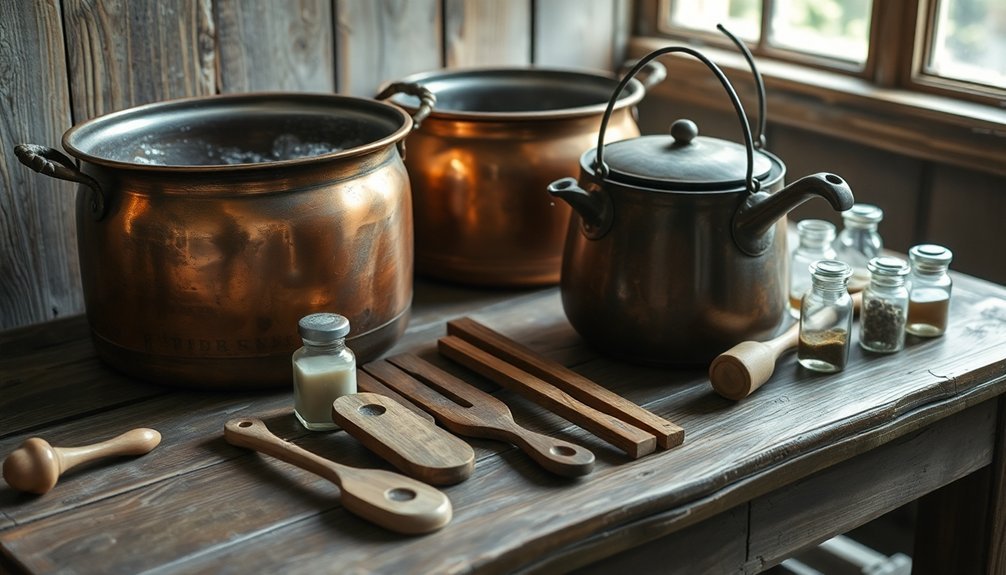
While we now take commercial soaps for granted, the art of soap making dates back thousands of years, with evidence of soap-like substances appearing around 2800 BC in ancient Babylon.
At the heart of this ancient craft stood the soap cauldron – traditionally crafted from copper for its superior heat distribution properties.
Master soap makers cherished their copper cauldrons, whose unmatched heat distribution transformed simple ingredients into luxurious cleansing bars.
You'll find that Marseille, France became a soap-making hub by the 16th century, where specialized factories emerged using large cauldrons to produce their famous olive oil-based soaps. The traditional manufacturing process involves saponification au chaudron, which is still used by authentic Marseille soap factories today.
By 1786, 48 factories operated there.
Over time, improvements in cauldron technology shifted from wood-fired heat to steam systems, offering soap makers better temperature control and safety.
Today's largest cauldrons, like those at Fer à cheval factory, can produce an impressive 15 tons per cooking cycle.
Wooden Molds: From Pioneer Patterns to Modern Designs
Simplicity marked the wooden soap molds used by early American pioneers, contrasting sharply with today's sophisticated designs. You'll find that these early settlers crafted basic wooden frames from readily available materials, using them to shape soaps made from animal fat and lye derived from wood ash. Similar to the Romans who produced soap manually from ashes and animal fats, these pioneers continued ancient traditions in their soap-making practices.
| Era | Features | Benefits |
|---|---|---|
| Colonial | Simple frames | Accessibility |
| Pioneer | Hand-carved designs | Tradition |
| Modern | Cutting slots | Precision |
Today's wooden molds offer significant advantages through their insulating properties, helping control temperature during curing. While they require maintenance and regular lining to prevent sticking, many soap makers prefer them for their rustic aesthetic appeal. The evolution from simple pioneer patterns to today's designs with integrated cutting slots represents both practical innovation and reverence for traditional craftsmanship.
Vintage Lye Measuring Tools and Safety Equipment
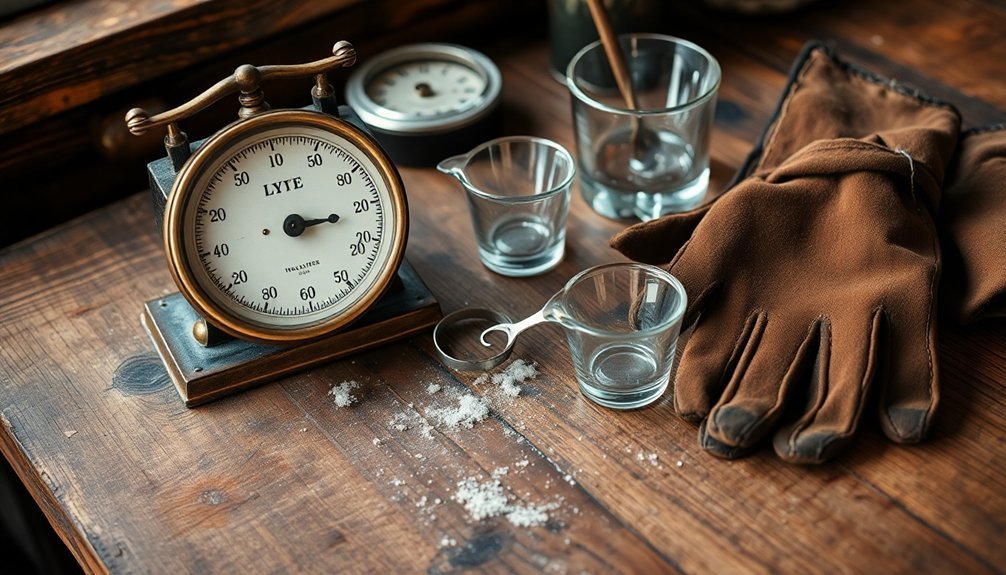
Because lye represented one of the most dangerous elements in historical soap-making, specialized tools and safety equipment evolved to protect craftspeople from burns and chemical exposure.
Glass measuring jugs provided accurate lye measurements, while non-aluminum metal and enamelware containers prevented dangerous chemical reactions. Bronze ladles and hand-forged tools offered durability when handling caustic substances.
For protection, you'd find early soap makers wearing handmade aprons, glass spectacles, and occasionally copper gloves. They'd create dedicated outdoor spaces for soap-making to minimize home contamination. Historical soap makers understood the importance of proper cleanup after handling caustic materials to maintain workspace safety.
Mercury and glass thermometers helped monitor critical temperatures during the process. Community knowledge sharing proved essential, with soap makers documenting safe practices in personal notebooks and passing techniques to fellow craftspeople through generations.
Antique Soap Cutters and Their Unique Designs
You'll find antique soap cutters with beveled edges offered cleaner cuts and reduced soap waste during production, making them prized tools for serious soap makers.
Modern soap makers can achieve similar results with tools like the Acrylic Soap Beveler which provides precision for professional-looking bars.
Traditional scoring patterns allowed artisans to mark bars for easier breaking later, giving customers flexibility to use smaller portions as needed.
These scoring designs varied regionally, with Mediterranean patterns featuring deeper cuts and Northern European designs often incorporating family or guild symbols alongside functional score lines.
Beveled Edge Benefits
The elegant beveled edges of antique soap cutters aren't just for show—they serve multiple practical purposes for both soap makers and users alike.
When you create bars with beveled edges, you're enhancing their durability by reducing moisture absorption at the corners where soap typically deteriorates first.
Your customers will appreciate the professional finish and smooth feel of beveled-edge soaps. They're less likely to cause scratches when handled, making them safer and more comfortable to use.
This refined detail also distinguishes your products in the marketplace, helping you establish a recognizable brand identity.
If you're selling your handmade cleansers commercially, these polished edges create a consistent, high-quality appearance that signals craftsmanship and attention to detail—qualities that today's consumers seek in artisanal products.
While modern grid cutters have evolved to offer more efficient production, the antique designs often created unique character that mass-produced soaps lack.
Traditional Scoring Patterns
Looking beyond the edges to what adorns the surface, traditional scoring patterns represent another fascinating aspect of antique soap-making tools.
You'll find these designs were created using simple metal mechanisms that evolved over centuries of soap-making tradition. Early artisans relied on knives paired with rulers to achieve uniform bars, though consistency varied compared to modern standards.
This delightful inconsistency became the hallmark of handmade soap. As techniques advanced, specialized scoring tools emerged, allowing for more intricate patterns and designs. Many crafters found that scoring soap with a ruler helped achieve more uniform sizes while maintaining the handmade aesthetic.
The knife-and-ruler method might seem primitive, but it offered remarkable versatility. While lacking modern adjustable features, these antique tools created distinctive products that celebrated the craft's heritage.
Today's soap makers often draw inspiration from these traditional patterns, preserving the authentic character that makes handmade soap so special.
Traditional Stirring Implements: From Paddles to Specialized Spoons
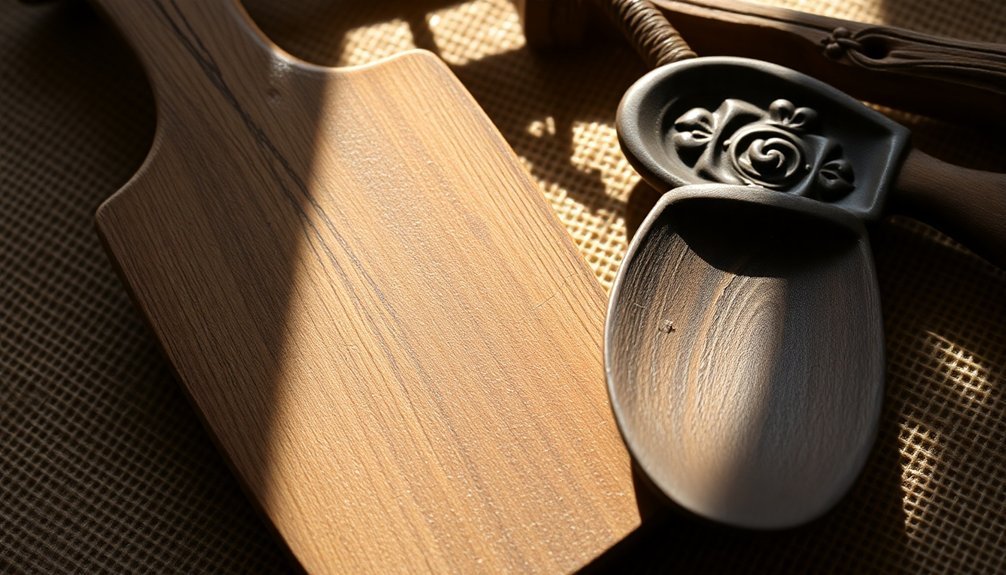
Traditional stirring implements showcase remarkable craftsmanship, from hand-carved wooden paddles featuring deep grain patterns to elegant copper stirring rods prized for their heat conductivity.
You'll find bone mixing tools were particularly valued for their smooth surfaces that prevented contamination during sensitive mixing processes. For making homemade cleaners, artisans often combined white vinegar and baking soda to create effective solutions that were both powerful and non-toxic.
These specialized tools reflect regional variations in design and highlight the artisan's understanding of chemical interactions between materials and cleansing ingredients.
Hand-carved Wooden Paddles
Handcrafted with purpose and precision, wooden paddles represent one of the most enduring tools for making traditional cleansers. You'll find these implements typically made from durable beech or maple, featuring long handles that let you stir large batches without strain. Their flat, wide ends excel at mixing dense ingredients and scraping pot sides. Today's wooden paddles come in various lengths ranging from 24 to 48 inches to accommodate different vessel sizes.
| Feature | Benefit | Traditional Use |
|---|---|---|
| Beech/maple wood | Heat-resistant, durable | Stirring hot soap mixtures |
| Long handle | Reduces user fatigue | Working with large batches |
| Flat, wide end | Even mixing distribution | Blending thick cleansers |
| Hand-carved designs | Aesthetic value, better grip | Cultural soap-making traditions |
Unlike metal alternatives, wooden paddles won't conduct heat or impart unwanted chemicals into your cleansers. They're available through artisanal marketplaces, specialty stores, and custom orders from local craftspeople.
Copper Stirring Rods
While wooden paddles became staples in traditional cleansing recipes, copper stirring rods emerged as specialized tools for more precise applications. Valued for their excellent heat conductivity, these slender implements allowed artisans to control temperature while mixing delicate ingredients.
Unlike glass alternatives, copper could transfer warmth directly to the mixture, activating certain botanical components. The tungsten carbide coating used in modern copper tools draws inspiration from these historical implements, providing superior durability and performance.
When working with antique copper stirring rods, you'll appreciate:
- Their alchemical heritage – once believed to impart mystical properties to medicinal preparations
- The gentle mixing action that's perfect for emulsifying oils without introducing air
- Their antimicrobial properties that helped preserve the purity of early cleansers
Despite their benefits, copper's softness made these tools less suitable for heavy-duty mixing, and their tendency to develop patina required regular maintenance.
Bone Mixing Tools
Beyond the domain of copper implements, bone mixing tools represent another fascinating chapter in cleansing preparation history. You'll find these durable implements were carefully crafted from animal bones, shaped and polished to create smooth surfaces ideal for blending cleansing compounds without contamination. Modern bone mixing tools employ a rotating axis paddle design that ensures thorough blending similar to these historical implements.
| Tool Type | Traditional Use | Modern Equivalent |
|---|---|---|
| Bone Paddle | Mixing thick soap bases | Silicone spatula |
| Curved Stirrer | Blending fragrant oils | Laboratory stirring rod |
| Bone Spoon | Measuring and incorporating herbs | Digital dispensing tool |
Unlike today's mass-produced tools, these bone implements were often passed down through generations, developing a patina that told stories of countless batches of handmade soaps and cleansers. Their ergonomic designs, created through practical experience rather than engineering studies, provided remarkable comfort during extended periods of mixing.
Herb Grinders and Mortar & Pestles for Natural Additives
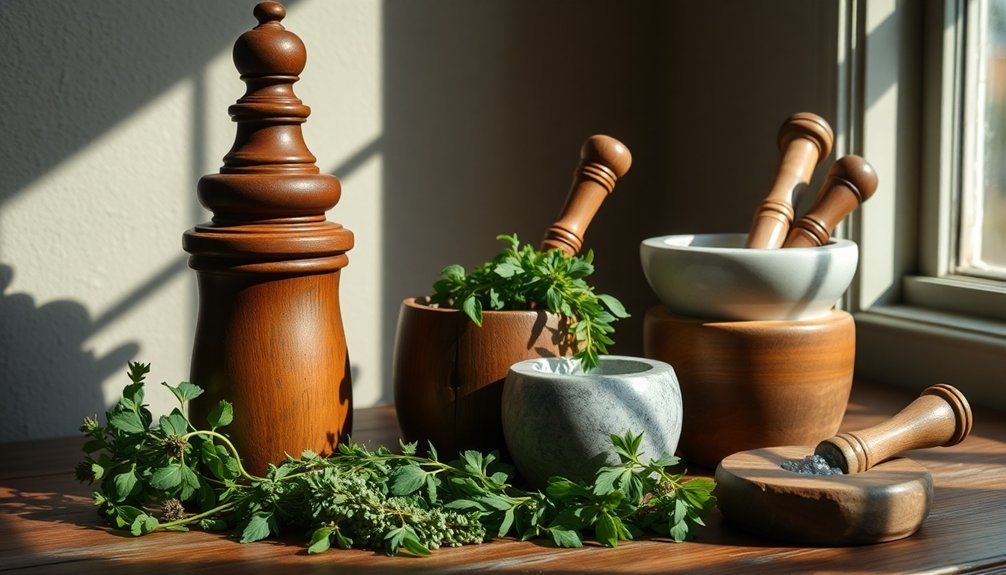
Since ancient civilizations first discovered the power of herbs, craftspeople have refined tools to release their potential in cleansers. The mortar and pestle, dating back thousands of years, remains unrivaled for creating custom herb blends without chemical contamination.
Ancient wisdom meets modern craft in the humble mortar and pestle—time-honored guardians of herbal purity.
You'll find these tools crafted from marble, granite, or ceramic—each material offering unique grinding properties. A quality set like the ChefSofi Extra Large provides the durability and versatility needed for various herbal preparations.
When working with these traditional tools, consider:
- Material selection – Choose marble for delicate herbs and granite for tougher ingredients
- Grinding technique – Hand-grinding preserves essential oils and flavors lost in electric alternatives
- Proper seasoning – Prepare your stone mortar before use to prevent flavor absorption and enhance longevity
These ancient tools allow you to create personalized natural additives with improved bioavailability for your handcrafted cleansers.
Oil Presses and Rendering Equipment for Raw Ingredients
The ancient art of extracting oils parallels the herb preparation process in handmade cleansers. You'll find traditional oil presses constructed from wood, iron, or steel, designed to extract precious oils from olives, sunflower seeds, and castor beans—all prized for their unique skincare benefits.
For rendering animal fats, you'll need specialized equipment. Stainless steel kettles resist corrosion while extracting clean fats for soap bases. Double boiler setups prevent scorching, while soapstone containers offer superior heat retention for traditional processing methods. When properly maintained, these tools create the optimal equal parts mixture of oils like castor and sunflower that have proven effective for natural face cleansing methods.
These historic tools connect you to centuries-old cleansing traditions. From medieval soap making with rendered fats to the oil cleansing methods using castor or grapeseed oil, you're tapping into sustainable practices that predate commercial production—while creating products that hydrate, protect, and nourish the skin.
Temperature Monitoring: From Tallow Tests to Vintage Thermometers
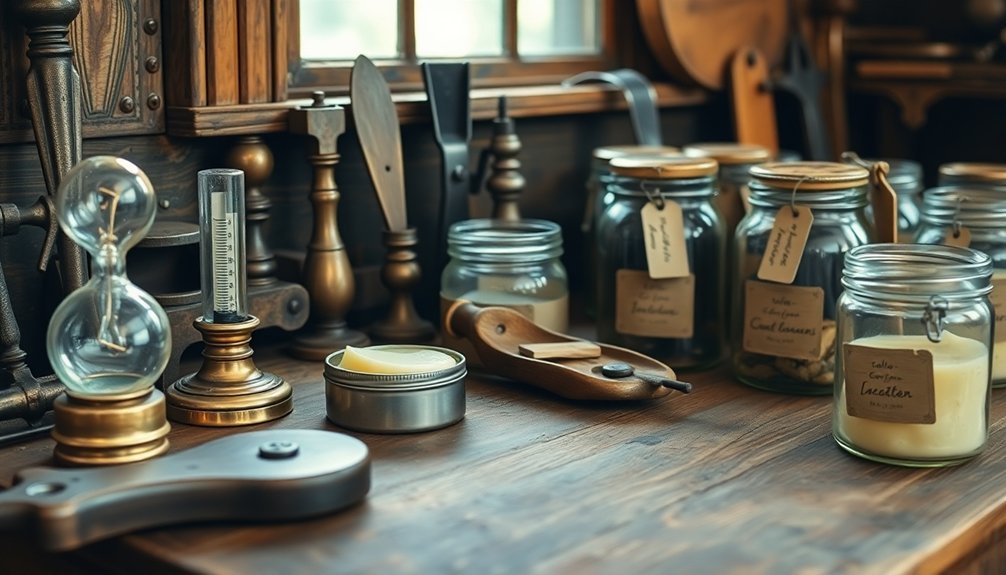
Temperature monitoring represents one of the most critical aspects of traditional soap making, evolving dramatically from intuitive methods to precision instruments.
Vintage soap makers relied on observational techniques like tallow tests and water bath methods before thermometers became standard tools. They'd judge temperatures through tactile assessment and visual cues, developing remarkable intuition through years of practice. Modern soap makers now understand that maintaining optimal temperatures between 120 to 130°F for both lye and oils produces the highest quality soaps.
The wisdom of touch guided master soap crafters, their fingers serving as thermometers in an era before scientific precision.
Three key temperature monitoring advancements in soap making history:
- Glass mercury or alcohol thermometers replaced intuitive methods, offering the first quantifiable measurements.
- Water bath and ice bath techniques provided crude but effective temperature control for lye solutions.
- Sunlight testing served as a primitive visual assessment method before modern tools existed.
Today's digital and infrared thermometers offer precision that historical craftsmen could only dream of, though some artisans still appreciate vintage analog instruments for their aesthetic appeal and connection to tradition.
Soap Curing Racks and Storage Solutions of Yesteryear
Craftsmanship in soap curing evolved dramatically over centuries, with historical artisans developing ingenious storage solutions long before modern climate control existed.
You'll find traditional drying racks with lattice structures were foundational, allowing proper air circulation around freshly cut soap bars.
Wall-mounted and hanging curing racks maximized limited workshop space, while rotating designs enabled easy access to bars requiring periodic turning.
For storage, wooden crates and wicker baskets provided breathable environments, while cotton and linen wrappings preserved delicate fragrances.
Stone cellars offered naturally cool, dry spaces ideal for lengthy curing periods.
The most innovative designs included folding racks for portable operations and tiered systems that accommodated different-sized products.
These thoughtful solutions weren't merely functional—they reflected generations of knowledge passed through workshops, museums, and community demonstrations that still inspire today's artisanal soap makers.
Modern homemade soap makers typically need 30-day curing periods for their products to properly harden and develop quality.
Packaging Tools: Vintage Wrappers, Stamps, and Presentation Methods
Once soap bars completed their curing journey, artisans faced a new challenge—packaging their creations to preserve quality while enticing customers.
Vintage packaging tools offered both functionality and charm, combining protection with marketing appeal. You'll find these antique packaging methods still inspire today's artisanal soap makers.
- Paper-Based Systems – Kraft paper and parchment wraps protected soaps while letterpress machines and relief printers created distinctive branding on these materials. These traditional wrappings were prized for being 100% biodegradable while still offering significant product protection.
- Embellishment Tools – Hand-carved stamps, wax seals, and foil stamping equipment added luxury touches that transformed simple wrappings into keepsakes.
- Display Furnishings – Wooden crates, vintage trunks, and antique glass jars showcased products in ways that told stories and elevated the shopping experience.
Frequently Asked Questions
How Can Antique Tools Affect the Quality of Modern Handmade Cleansers?
Antique tools can enhance your cleanser quality through precise material handling, natural ingredient processing, and time-tested mixing techniques. You'll achieve better consistency and authentic textures while honoring traditional craftsmanship in your modern products.
Are Reproduction Antique Soap-Making Tools as Effective as Originals?
Yes, you'll find reproduction soap-making tools can be just as effective as originals. They maintain traditional capabilities while often incorporating subtle improvements in durability and consistency that make your soap-making process more reliable.
Which Antique Soap-Making Tool Is Most Valuable to Collectors Today?
Elaborate wooden carved soap molds fetch the highest prices among collectors. You'll find these rare 19th-century pieces commanding premium values, especially those with intricate designs or those bearing original maker's marks in excellent condition.
Can Modern Materials Safely Replace Traditional Ones in Antique Tools?
Yes, you can safely replace traditional materials in antique tools with modern alternatives. Use food-grade stainless steel instead of tin, silicone for wooden components, and non-toxic finishes while maintaining the tool's functionality and character.
What Are the Environmental Benefits of Using Old-World Cleansing Methods?
You'll reduce chemical pollution, conserve resources, enhance indoor air quality, and save money by using old-world cleansing methods. They're biodegradable, emit fewer VOCs, and don't contribute to manufacturing-related greenhouse gas emissions.
In Summary
You've now glimpsed the fascinating world of traditional soap making tools. From copper cauldrons to wooden molds, these implements aren't just functional—they're vessels of heritage. Whether you're a collector or a craftsperson, these antique tools connect you to generations of artisans who created cleansers by hand. Embrace these time-tested instruments, and you'll find they bring authenticity and character to your own soap making journey.

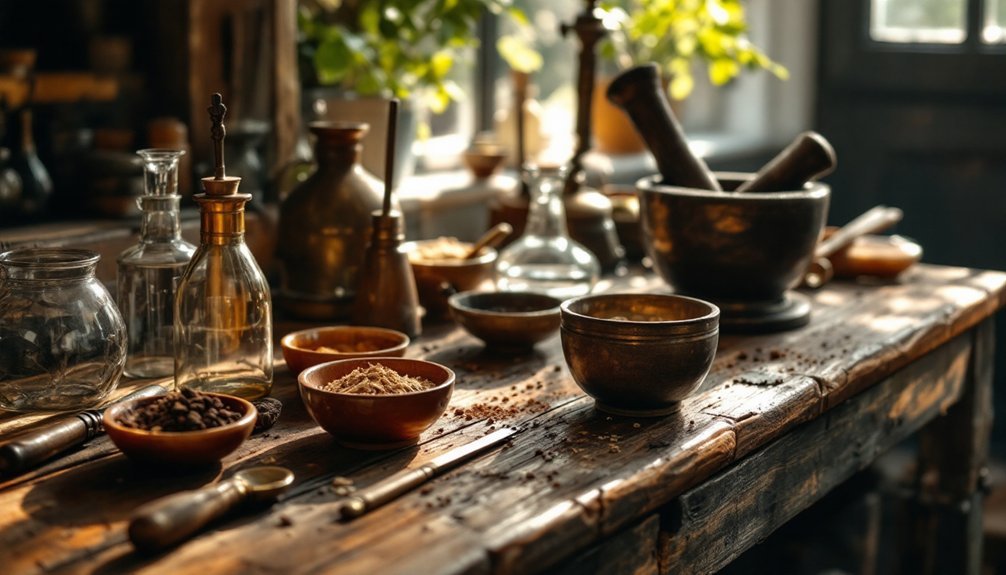



Leave a Reply